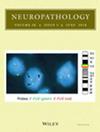Acute respiratory failure caused by brainstem demyelinating lesions in an older patient with an atypical relapsing autoimmune disorder
IF 1.3
4区 医学
Q4 CLINICAL NEUROLOGY
引用次数: 0
Abstract
An 84‐year‐old man presented with somnolence, dysphagia, and right hemiplegia, all occurring within a month, approximately one year after initial admission due to subacute, transient cognitive decline suggestive of acute disseminated encephalomyelitis involving the cerebral white matter. Serial magnetic resonance imaging (MRI) studies over that period revealed three high‐intensity signal lesions on fluid‐attenuated inversion recovery images, appearing in chronological order in the left upper and left lower medulla oblongata and left pontine base. Despite some clinical improvement following methylprednisolone pulse therapy, the patient died of respiratory failure. Autopsy revealed four fresh, well‐defined lesions in the brainstem, three of which corresponded to the lesions detected radiologically. The remaining lesion was located in the dorsal medulla oblongata and involved the right solitary nucleus. This might have appeared at a later disease stage, eventually causing respiratory failure. Histologically, all four lesions showed loss of myelin, preservation of axons, and infiltration of lymphocytes, predominantly CD8‐positive T cells, consistent with the histological features of autoimmune demyelinating diseases, particularly the confluent demyelination observed in the early and acute phases of multiple sclerosis (MS). In the cerebral white matter, autoimmune demyelination appeared superimposed on ischemic changes, consistent with the cerebrospinal fluid (CSF) and MRI findings on initial admission. No anti‐AQP4 or MOG antibodies or those potentially causing autoimmune encephalitis/demyelination were detected in either the serum or CSF. Despite several similarities to MS, such as the relapsing–remitting disease course and lesion histology, the entire clinicopathological picture in the present patient, especially the advanced age at onset and development of brainstem lesions in close proximity within a short time frame, did not fit those of MS or other autoimmune diseases that are currently established. The present results suggest that exceptionally older individuals can be affected by an as yet unknown inflammatory demyelinating disease of the CNS.一名患有非典型复发性自身免疫性疾病的老年患者因脑干脱髓鞘病变导致急性呼吸衰竭
一名 84 岁的男性因亚急性、一过性认知能力下降入院,入院约一年后,在一个月内出现嗜睡、吞咽困难和右侧偏瘫,提示为急性播散性脑脊髓炎累及脑白质。在此期间进行的连续磁共振成像(MRI)检查发现,在流体增强反转恢复图像上有三个高强度信号病灶,按时间顺序出现在左侧延髓上部和左侧延髓下部以及左侧桥脑底部。尽管经过甲基强的松龙脉冲治疗后临床症状有所好转,但患者还是死于呼吸衰竭。尸检发现脑干有四个新鲜、界限清楚的病灶,其中三个与放射学检测到的病灶一致。其余一个病灶位于延髓背侧,累及右侧孤核。这可能出现在疾病的后期,最终导致呼吸衰竭。从组织学角度看,所有四个病灶均显示髓鞘缺失、轴突保留和淋巴细胞浸润,主要是 CD8 阳性 T 细胞,这与自身免疫性脱髓鞘疾病的组织学特征一致,尤其是多发性硬化症(MS)早期和急性期的融合性脱髓鞘。在脑白质中,自身免疫性脱髓鞘与缺血性改变相叠加,与最初入院时的脑脊液(CSF)和核磁共振成像结果一致。血清或脑脊液中均未检测到抗AQP4或MOG抗体或可能导致自身免疫性脑炎/脱髓鞘的抗体。尽管与多发性硬化症有几处相似之处,如复发-缓解病程和病变组织学,但该患者的整个临床病理特征,尤其是高龄发病和在短时间内脑干病变相邻发展的特征,与多发性硬化症或目前已确定的其他自身免疫性疾病的特征并不相符。本研究结果表明,年龄特别大的人也可能患上一种尚不为人知的中枢神经系统炎症性脱髓鞘疾病。
本文章由计算机程序翻译,如有差异,请以英文原文为准。
求助全文
约1分钟内获得全文
求助全文
来源期刊

Neuropathology
医学-病理学
CiteScore
4.10
自引率
4.30%
发文量
105
审稿时长
6-12 weeks
期刊介绍:
Neuropathology is an international journal sponsored by the Japanese Society of Neuropathology and publishes peer-reviewed original papers dealing with all aspects of human and experimental neuropathology and related fields of research. The Journal aims to promote the international exchange of results and encourages authors from all countries to submit papers in the following categories: Original Articles, Case Reports, Short Communications, Occasional Reviews, Editorials and Letters to the Editor. All articles are peer-reviewed by at least two researchers expert in the field of the submitted paper.
 求助内容:
求助内容: 应助结果提醒方式:
应助结果提醒方式:


